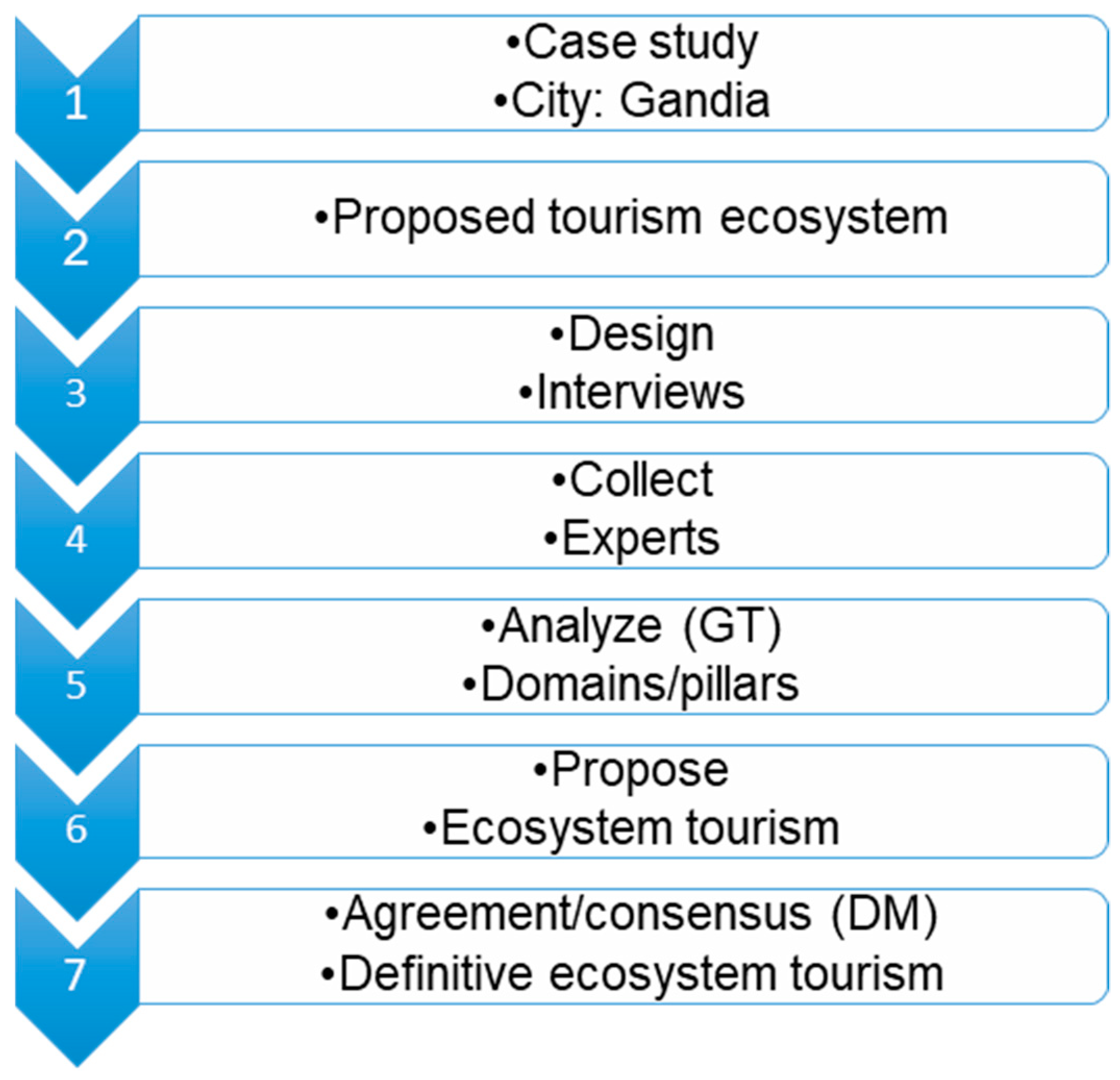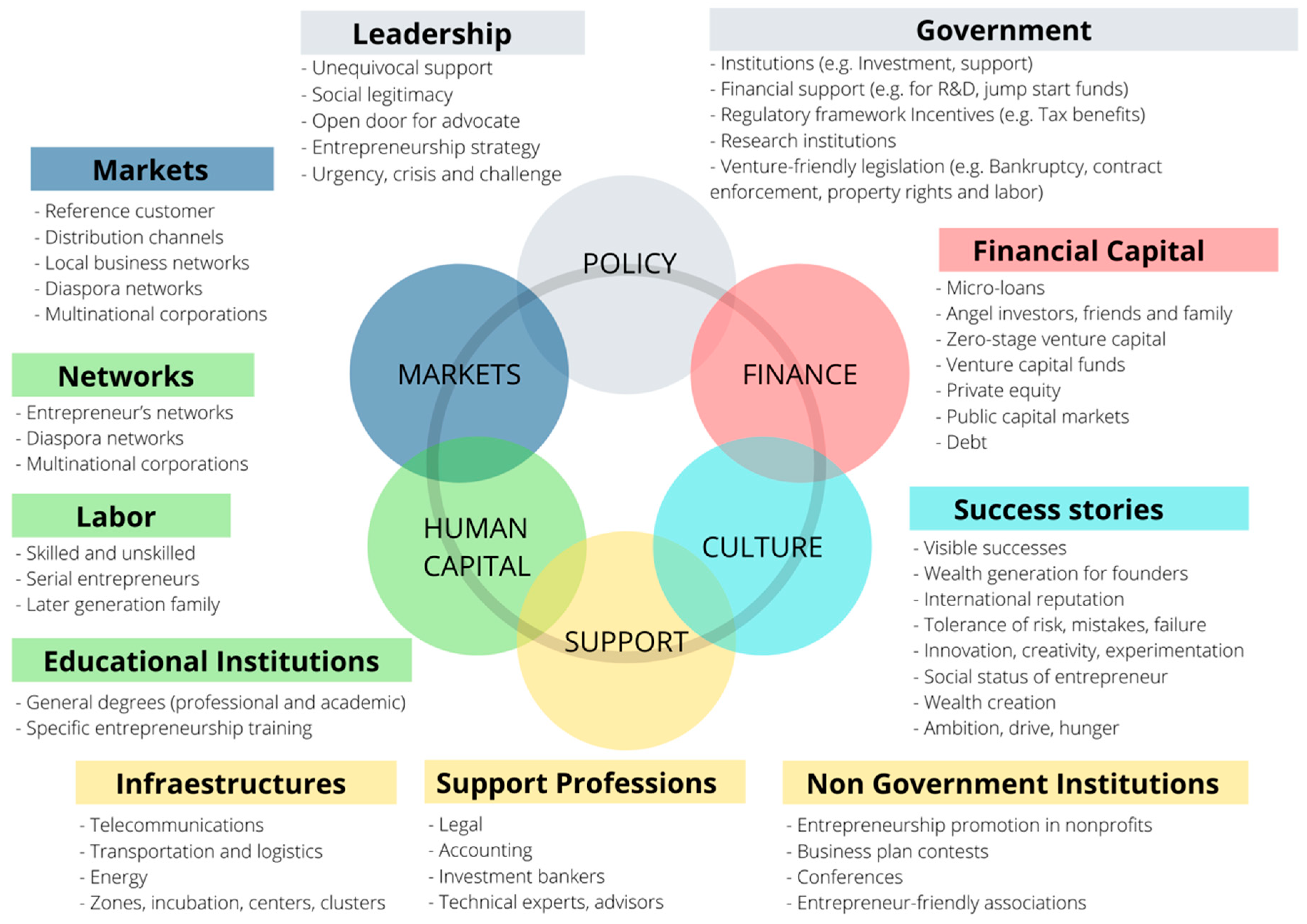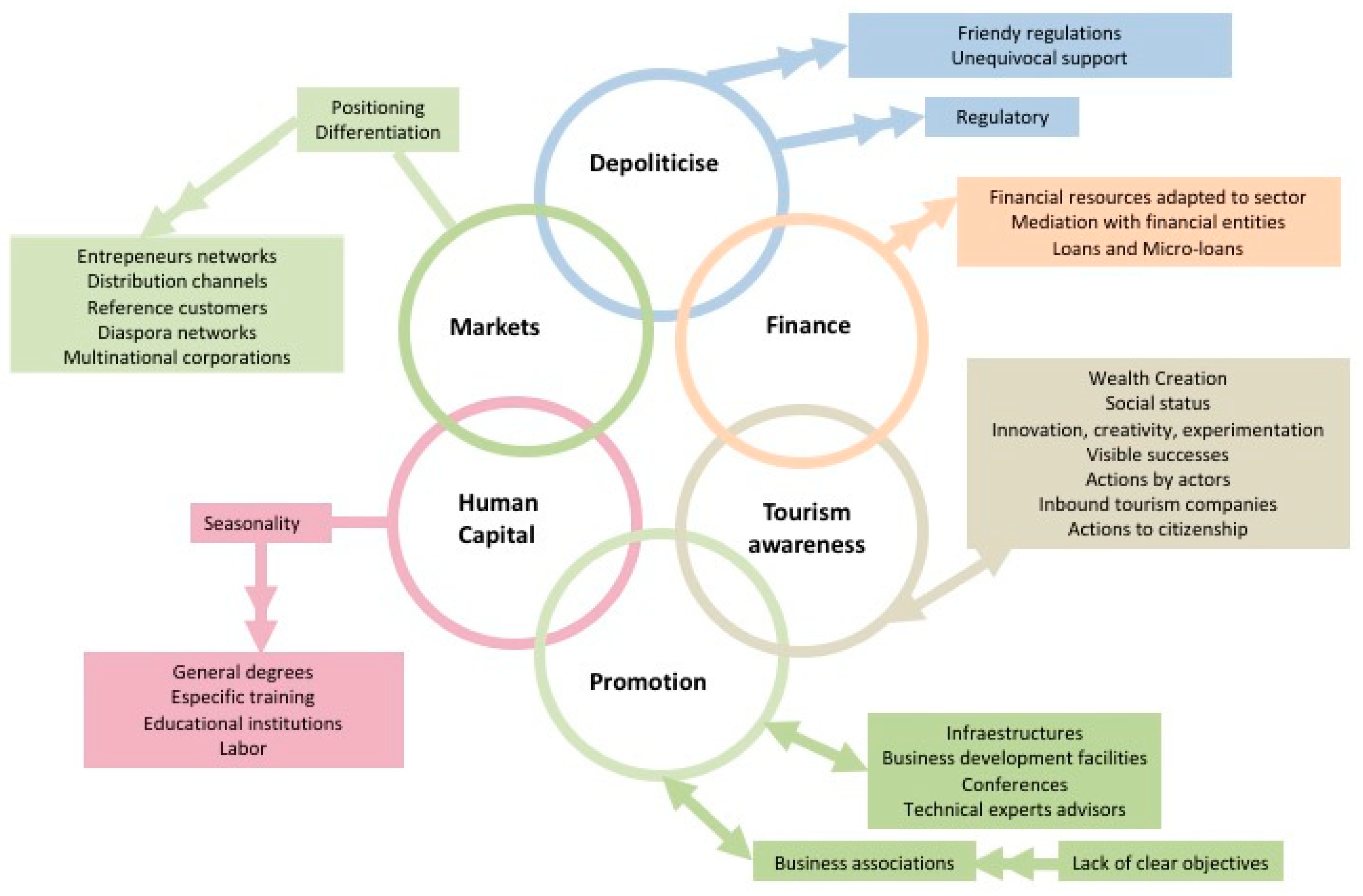Ecosystem Model Proposal in the Tourism Sector to Enhance Sustainable Competitiveness
Abstract
1. Introduction
“To provide a product/service system, an historically self-organized or managerially designed multilayer social network consist of actors that have different attributes, decision principles and beliefs”
“The fundamental idea of an entrepreneurship ecosystem is to create a conductive environment to support innovation, the formation of new successful firms and corresponding sustainable employment growth within a specific geographic region”
2. Theoretical Background and Initial Model Development
2.1. Entrepreneurship Ecosystems: A Reference Model
- Politicians, government agencies, universities and business associations;
- Startups, SMEs and existing large companies, which drive economic development through innovation. Among these companies there may be those that provide services to entrepreneurs, such as patent agencies or venture capital companies, for example.
- Policies: Support from the Administration and public bodies, both at the legislative level and creating regulations and initiatives that foster entrepreneurial activity;
- Financing: Easy and fast access to financing, both banking and private;
- Culture: Giving diffusion and visibility to success stories, and a good reputation to entrepreneurs;
- Support: All those services, resources and initiatives to support the entrepreneur;
- Human Capital: Educational Institutions, Universities and training for entrepreneurs;
- Markets: Establishment of entrepreneur networks, existence of first customers that test beta-products (early adopters) and from which feedback can be received.
- Do not try to create another Silicon Valley. Nowadays it is more a magnet for attracting entrepreneurs who come there to settle and not an environment where entrepreneurship is created from scratch;
- The local ecosystem must be created based on the existing conditions and their circumstances;
- The private sector must be involved and give support from the beginning;
- Although, as mentioned above, the financing needs of startups are lower and capital can reach a greater number of entrepreneurs, companies with high potential must be favored;
- It is essential to have success stories, disseminate them and inspire others;
- A cultural mindset which promotes a good image of entrepreneurs must be encouraged;
- Easy financing or flooding startups with money must be avoided since these measures often have the opposite effect;
- Clusters foster entrepreneurial spirit, so their growth must be supported organically;
- The creation of companies and their growth should be encouraged by adapting and reforming laws and bureaucracy.
2.2. Proposed Model of an Urban Tourism Ecosystem in the City of Gandia
- Policies: Supports from the Administration and public organisms, at a legislative level as well as creating regulations and initiatives that favor tourist activity;
- Financing: Fast and easy access to financing, both banking and privately, to launch projects and initiatives and for companies within the tourism sector;
- Culture: Diffusion and visibility of the initiatives of the sector, creating a local sense of affinity and belonging to the city as a tourism brand;
- Support: All those services, resources and initiatives to support the sector;
- Human Capital: Educational Institutions, Universities and training for professionals of the sector that enable work to be carried out in a professional manner;
- Markets: Promotion and support to networks and associations of professionals, existence of first customers that can try new products and from which feedback can be received.
3. Materials and Methods
- The case design and its type are chosen by the researcher;
- It is necessary to be aware of the problem and context;
- The unit to analyze must be identified;
- Data must be reliable and valid (triangulation).
- Conceptualisation and explanation of the problem (corresponding to steps 1 and 2, Figure 3);
- Recopilation of the information (corresponding to steps 3 and 4, Figure 3);
- Structuration and organisation of data, (corresponding to step 5, Figure 3);
- Socialisation and adjustment of data (corresponding to step 6, Figure 3);
- Elaboration of the thesis (corresponding to step 7, Figure 3).
4. Results
- Breaking the strong seasonality of tourist flows;
- Adapting the human resources management model to improve the ability to attract and retain talent;
- Improving the competitive environment;
5. Conclusions, Limitations and Future Lines of Research
Author Contributions
Funding
Conflicts of Interest
References
- Tsujimoto, M.; Kajikawa, Y.; Tomita, J.; Matsumoto, Y. A review of the ecosystem concept—Towards coherent ecosystem design. Technol. Forecast. Soc. Chang. 2017, 136, 32. [Google Scholar] [CrossRef]
- Simatupang, T.M.; Schwab, A.; Lantu, D.C. Building Sustainable Entrepreneurship Ecosystems. Int. J. Entrep. Small Bus. 2015, 26, 1598. [Google Scholar] [CrossRef]
- Van Stel, A.; Carree, M.; Thurik, R. The effect of entrepreneurial activity on national economic growth. Small Bus. Econ. 2005, 24, 311–321. [Google Scholar] [CrossRef]
- Consejo Europeo. Consejo Europeo de Lisboa; Conclusiones de la Presidencia; Consejo Europeo: Brussels, Belgium, 2000. [Google Scholar]
- Comisión de las Comunidades Europeas. Libro Blanco de la Comisión Europea, Un Nuevo Impulso Para la Juventud Europea; Comisión de las Comunidades Europeas: Brussels, Belgium, 2001. [Google Scholar]
- Babson College. About Daniel Isenberg. Available online: https://www.babson.edu/academics/executive-education/expanding-entrepreneurship/babson-entrepreneurship-ecosystem-platform/daniel-isenberg/ (accessed on 6 November 2019).
- Isenberg, D.J. How to start an Entrepreneurial Revolution. Harv. Bus. Rev. 2010, 88, 40–51. [Google Scholar]
- Isenberg, D.J. The Entrepreneurship Ecosystem Strategy as a New Paradigm for Economic Policy: Principles for Cultivating Entrepreneurship, the Babson Entrepreneurship Ecosystem Project; Babson College: Wellesley, MA, USA, 2011. [Google Scholar]
- Ács, Z.J.; Szerb, L.; Autio, E. The Global Entrepreneurship and Development Institute; Global Entrepreneurship Index: Washington, DC, USA, 2015. [Google Scholar]
- Foster, G.; Shimizu, C. Entrepreneurial Ecosystems Around the Globe and Company Growth Dynamics. In Report Summary for the Annual Meeting of the New Champions; World Economic Forum: Geneva, Switzerland, 2013. [Google Scholar]
- Mason, C.; Brown, R. Entrepreneurial Ecosystems and Growth Oriented Entrepreneurship; Final Report; OECD: Paris, France, 2014; Volume 30, pp. 77–102. [Google Scholar]
- Moore, J.F. Predators and prey: Anew ecology of competition. Harv. Bus. Rev. 1993, 71, 75–86. [Google Scholar]
- Álvarez, P.; García, S.I.; Menéndez, C.; Federico, J.; Kantis, H. El ecosistema emprendedor de la Ciudad Autónoma de Buenos Aires. Una mirada exploratoria. Pymes Innovación y Desarro 2016, 4, 146–174. [Google Scholar]
- Brekke, T. Entrepreneurship and path dependency in regional development. Entrep. Reg. Dev. Int. J. 2015, 27, 202–218. [Google Scholar] [CrossRef]
- Garud, R.; Kumaraswamy, A.; Karnøe, P. Path dependence or path creation? J. Manag. Stud. 2010, 47, 760–774. [Google Scholar] [CrossRef]
- Saxenian, A. Regional networks: Industrial adaptation in Silicon Valley and route 128. Cityspace J. Policy. Dev. Res. 1996, 2, 41–60. [Google Scholar]
- Hwang, V.W.; Horowitt, G. The Rainforest: The Secret to Building the Next Silicon Valley; Regenwald: Los Altos Hills, CA, USA, 2012. [Google Scholar]
- Prahalad, C.K. La Oportunidad de Negocios en la Base de la Pirámide: un Modelo de Negocio Rentable, Que Sirve a Las Comunidades Más Pobres; Editorial Norma; Wharton School Publishing: Upper Saddle River, NJ, USA, 2005. [Google Scholar]
- Napier, G.; Hansen, C. Ecosystems for Young Scalable Firms; FORA Group: Ankara, Turkey, 2011. [Google Scholar]
- Mason, C.M.; Harrison, R.T. After the exit: Acquisitions, entrepreneurial recycling and regional economic development. Reg. Stud. 2006, 40, 55–73. [Google Scholar] [CrossRef]
- Marmer, M.; Herrmann, B.L.; Berman, R. Startup Genome Report: A New Framework for Understanding Why Startups Succeed; Startup Genome: San Francisco, CA, USA, 2011. [Google Scholar]
- Instituto Nacional de Estadística. Available online: https://www.ine.es (accessed on 7 November 2019).
- Instituto Valenciano de Tecnologías Turísticas. Libro Blanco para una nueva estrategia turística de la Comunidad Valenciana; Instituto Valenciano de Tecnologías Turísticas: Benidorm, Spain, 2017. [Google Scholar]
- Sigalat, E.; Roig, B.; Baviera, M.; Buitrago, J.; Escribá, C. Diagnóstico Territorial de La Safor; Universitat Politècnica de València: Valencia, Spain, 2017. [Google Scholar]
- Secretaría de Estado de Turismo. Plan Nacional e Integral de Turismo 2012–2015; Ministerio de Industria, Energía y Turismo: Madrid, Spain, 2015. [Google Scholar]
- Las Provincias. Gandia es el Undécimo Destino Con Mejor Ocupación Hotelera de Toda España. Available online: https://www.lasprovincias.es/safor/gandia-undecimo-destino-20191107011433-ntvo.html?fbclid=IwAR1vvgBcROmlD-hVkWnZ2D31LNpor8OX2XW7Rkeaznn0xccPsZXOfNTqSI0 (accessed on 6 November 2019).
- Spanish Tourism Council. Plan de Turismo Español Horizonte 2020; Spanish Tourism Council: Madrid, Spain, 2007. [Google Scholar]
- Santandreu-Mascarell, C.; Morant-Martínez, O. Modelo dinamizador del turismo urbano: Gestión eficaz y eficiente del sector público y privado. In Proceedings of the XXXI Congreso AEDEM Annual Meeting, Madrid, Spain, 7–9 June 2017. [Google Scholar]
- Díaz, S.; Mendoza, V.; Porras, C. Elaboración de estudios de caso y control. Rev. Razón y Palabra México 2011, 1, 2–22. [Google Scholar]
- Yin, R. Investigación sobre estudio de casos: Diseño y métodos. In Applied Social Research Methods Series; Sage: London, UK, 1994. [Google Scholar]
- Sampieri, R.H. Metodología de la Investigación: Las Rutas Cuantitativa, Cualitativa y Mixta; McGraw Hill México: Contadero, Mexico, 2018. [Google Scholar]
- Martínez Carazo, P.C. El método de estudio de caso Estrategia metodológica de la investigación científica. Rev. Científica Pensam. y Gestión 2011, 165–193. [Google Scholar]
- Chetty, S. The case study method for research in small- and médium-sized firms. Int. Small Bus. J. 1996. [Google Scholar] [CrossRef]
- Partington, D. Building Grounded Theories of Management Action. Br. J. Manag. 2000, 11, 91–102. [Google Scholar] [CrossRef]
- Goldkuhl, G. Conceptual Determination when Developing a Multi-Grounded Theory—Example: Defining ISD Method. In Proceedings of the 3rd European Conference on Research Methods in Business and Management, Reading, UK, 29–30 April 2004. [Google Scholar]
- Morant, O.; Santandreu, C.; Canós, L.; Millet, J. Valencia Startup Ecosystem: Una Aproximación al Ecosistema Emprendedor de Valencia y Sus Características Frente a Los Rankings. Econ. Ind. 2017, 404, 63–70. [Google Scholar]
- Garcia-Sabater, J.J.; Marin-Garcia, J.A. Can we still talk about continuous improvement? Rethinking enablers and inhibitors for successful implementation. Int. J. Technol. Manag. 2011, 55, 28–42. [Google Scholar] [CrossRef]
- Santandreu-Mascarell, C.; Canós-Darós, L.; Pons-Morera, C. Competencies and skills for future Industrial Engineers defined in Spanish degrees. J. Ind. Eng. Manag. 2011, 4, 13–30. [Google Scholar] [CrossRef][Green Version]
- García Espinosa, T. Evaluación de los Recursos Territoriales Turísticos Básicos. Las Playas de Gandía; Universitat Jaume I: Castellón, Spain, 2016. [Google Scholar]
- Ripoll, M.F. Propuesta de Elaboración de una guía Comunicacional Para la Realización de un Evento. Caso de Estudio: Gandía, Think Smart. Doctoral Dissertation, Universitat Politècnica de València, Valencia, Spain, 2016. [Google Scholar]
- Viana Lora, A. Destinos Turísticos Inteligentes. Sistemas de Información. Master’s Thesis, Universidad De Málaga, Málaga, Spain, 2016. [Google Scholar]
- Instituto Valenciano de Tecnologías Turísticas. X Barómetro de Redes Sociales y destinos turísticos de la Comunidad Valenciana; Instituto Valenciano de Tecnologías Turísticas: Benidorm, Spain, 2018. [Google Scholar]
- Instituto Valenciano de Tecnologías Turísticas. Actividad Turística y Cambio Climático en la Comunidad Valenciana; Instituto Valenciano de Tecnologías Turísticas: Benidorm, Spain, 2017. [Google Scholar]
- Pace, S. A Grounded Theory of the Flow Experiences of Web Users. Int. J. Hum. Comput. Stud. 2004, 60, 327–363. [Google Scholar] [CrossRef]
- Loo, R. The Delphi method: A powerful tool for strategic management. Polic. Int. J. Police Strateg. Manag. 2002, 25, 762–769. [Google Scholar] [CrossRef]
- Okoli, C.; Pawlowski, S.D. The Delphi method as a research tool: An example, design considerations and applications. Inf. Manag. 2004, 42, 15–29. [Google Scholar] [CrossRef]
- Grisham, T. The Delphi technique: A method for testing complex and multifaceted topics. Int. J. Manag. Proj. Bus. 2009, 2, 112–130. [Google Scholar] [CrossRef]
- Crouch, G.I.; Ritchie, J.B. Tourism, competitiveness, and societal prosperity. J. Bus. Res. 1999, 44, 137–152. [Google Scholar] [CrossRef]
- Uppink, L.; Soshkin, M. The Travel & Tourism Competitiveness Report 2019; World Economic Forum: Geneva, Switzerland, 2019. [Google Scholar]
- World Tourism Organization. International Tourism Highlights; UNWTO: Madrid, Spain, 2019. [Google Scholar]
- Gandiaempresarial.com. Invertir—Gandia Empresarial. Available online: http://gandiaempresarial.com/invertir/ (accessed on 5 November 2019).


© 2019 by the authors. Licensee MDPI, Basel, Switzerland. This article is an open access article distributed under the terms and conditions of the Creative Commons Attribution (CC BY) license (http://creativecommons.org/licenses/by/4.0/).
Share and Cite
Morant-Martínez, O.; Santandreu-Mascarell, C.; Canós-Darós, L.; Millet Roig, J. Ecosystem Model Proposal in the Tourism Sector to Enhance Sustainable Competitiveness. Sustainability 2019, 11, 6652. https://doi.org/10.3390/su11236652
Morant-Martínez O, Santandreu-Mascarell C, Canós-Darós L, Millet Roig J. Ecosystem Model Proposal in the Tourism Sector to Enhance Sustainable Competitiveness. Sustainability. 2019; 11(23):6652. https://doi.org/10.3390/su11236652
Chicago/Turabian StyleMorant-Martínez, Oscar, Cristina Santandreu-Mascarell, Lourdes Canós-Darós, and José Millet Roig. 2019. "Ecosystem Model Proposal in the Tourism Sector to Enhance Sustainable Competitiveness" Sustainability 11, no. 23: 6652. https://doi.org/10.3390/su11236652
APA StyleMorant-Martínez, O., Santandreu-Mascarell, C., Canós-Darós, L., & Millet Roig, J. (2019). Ecosystem Model Proposal in the Tourism Sector to Enhance Sustainable Competitiveness. Sustainability, 11(23), 6652. https://doi.org/10.3390/su11236652









